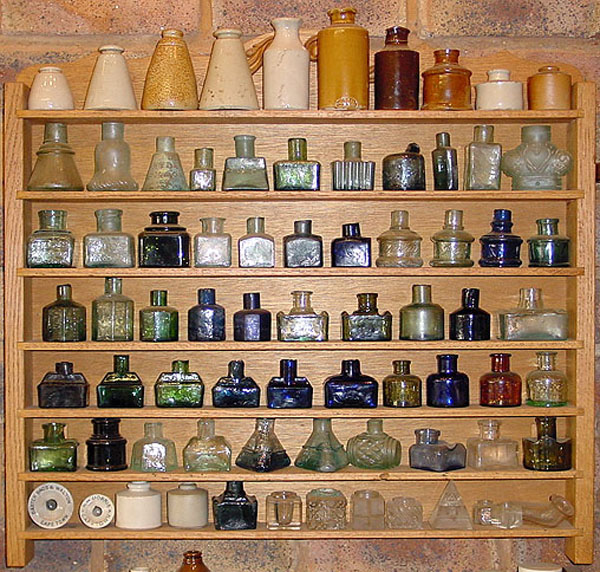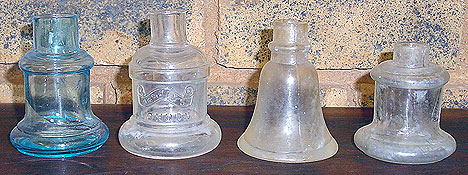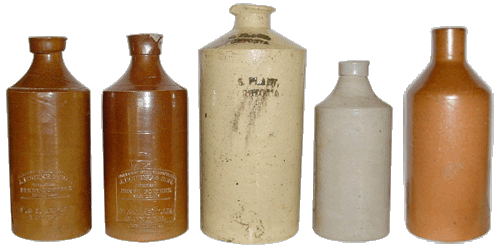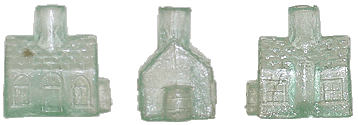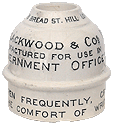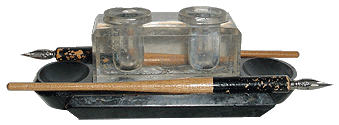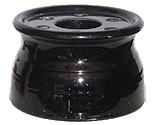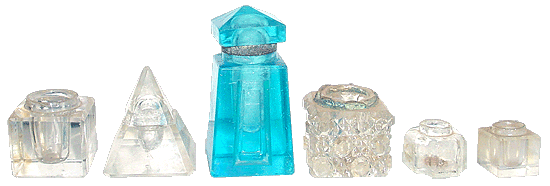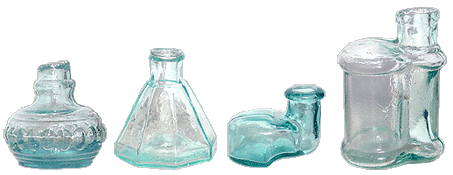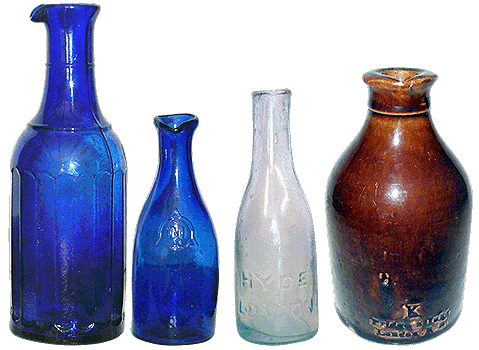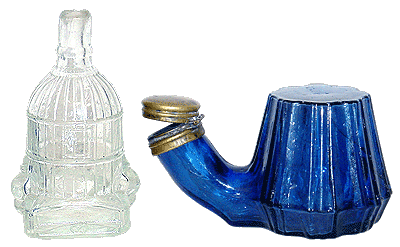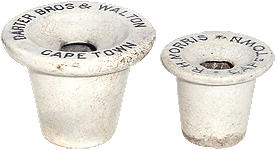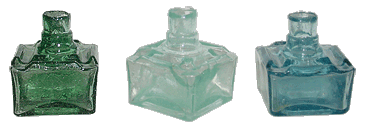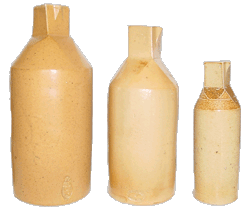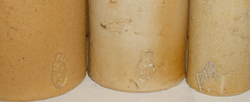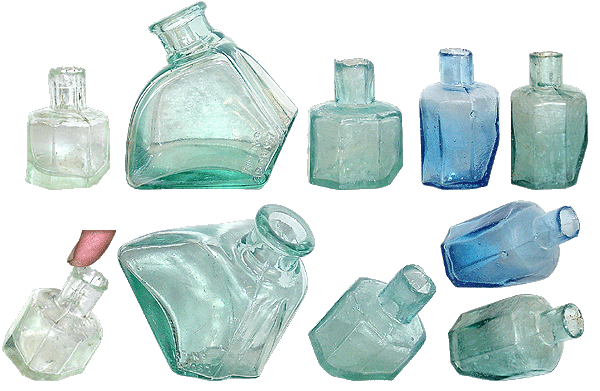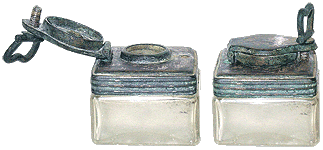|
Updated August 2006 Ink was first used about 2500BC in Ancient Egypt and China. The modern day digger / collector soon comes to realise that our Victorian forebearers spent most of their time either drinking (nothing wrong with that), cleaning house or writing letters...this observation is based on what one might find on a typical "dig". Ink bottles tend to be named after items which they closely resemble i.e umbrella, boat, tent, barrel, cottage, pyramid...etc. Where the shape is not characteristic then the names of the manufacturers are used for identification i.e Temple, Pridge, Field, Hyde, Blackwood, Derby, Hollidge...etc. I have recently "re-discovered" inks and have set about acquiring some really nice British and American examples for the website. The Inks which one digs in South Africa are rather bland and are, with very few exceptions, circular, boat shaped, square ribbed and nearly all aqua glass.
This picture taken during July 2004 shows the better specimens of my ink collection it also shows what a pleasant and interesting display even a small collection can make. Let us look at the collection again in a year or so. Aqua Glass (General)
Barrel Inks
Bell Inks Bell inks, described so because of their obvious shape may easily be confused with glue pots as they were similarly shaped
An unusual ice blue bottle followed by an "Arnold's London" (with pontil mark) and two classic shaped bottles.
A group of five aqua glass bell inks all dug in South Africa. Boat Inks
Bulk Inks
These bottles were mainly used for dispensing small quantities of ink into school desk recepticles . From the left, two early P & J Arnold bottles made by J. Bourne & Son Denby, a very unusual white glazed bottle stamped in five places "S. PLANT, PRETORIA" (dug in Kimberley), an early ink with curious applied top, a circular Doulton & Co Lambeth bulk ink and a cobalt-blue glazed small bulk ink. Cone Inks
Not much explanation needed here. It is generally accepted that the brown glazed bottles contained black or blue ink and the white, red ink. The first bottle (two-tone) is the smallest of three known sizes, I have not come across these anywhere else other than in the Dale Lewis collection. Cottage Inks
These inks are highly collectable and very rare. The British dealer I bought this from unfortunately was in too much of a hurry to list it on e-Bay to realise that what he described as a "hairline" was in fact a bad crack going right around the bottle from front to rear as can be seen. Cotton Reel Inks
Derby (All British)
Desk Inks
Blackwood & Co. Of 18 Bread St. Hill London were a well known ink manufacturer. An extemely rare glass desk ink dug in Kimberley and still in amazingly good condition. The base, which incorporates two pen rests and two nib holders is made of almost black (purple) glass. On the right is a standard circular desk ink with six pen holders.
Sadly all the hinges and most of the caps / covers of these inks are long gone. Exotic Inks
A beautiful (and extremely rare) ice blue bracelet ink, a pontilled early American umbrella, a Turtle ink and a strangely shaped bottle, the purpose of which we are not aware? Igloo Inks
Octagonal Inks
Penny Ink
Also known as dwarf ink the penny ink derives its name from the price paid for these early stoneware bottles. Pictured above, a group of five bottles containing black or blue ink, all dug in South Africa.
A goup of five red ink bottles. The middle one embossed on the shoulder "Hollidge, London". It is unusual for these penny / dwarf inks to bear any embossing or potters mark. Pourer Inks
A cobalt-blue medium sized pourer, a scarce small Morell, a Hyde London aqua glass and an unusual Pridge earthernware bottle picked up on a building site. Really Way-out Inks
A sheared neck birdcage ink showning the door and feeders on each side next to a cobalt-blue teakettle ink complete with cap. Round Inks
School Desk Inks
Spill Proof Inks
As the name implies, an ingenious idea from the turn of the previous century. The first picture shows the bottle in its upright position and to the right, the level of ink contained without spilling. Next, a British bottle with removable plug for cleaning and on the right, a spectacular pontilled early American bottle. Square Inks with double pen rests
Square Inks with four pen rests
A nice group of three early Victorian sheared neck inks. Square Top Inks
Generally accepted as having contained red ink (if you have ever dug one and cleaned it you will agree!) these salt-glazed Doulton Lambeth bottles are really beautiful. Each one bears a diamond registration mark which can be used to establish it's date of manufacture.
Tent Inks
Tipper Inks
Travelling Inks Antiquebottles.co.za is indebted to the honesty and integrity in their dealings, of the likes of Raymond Barker, William Bentley, Michael Flude, John Goulding, Peter Grant, Andrew Howitt, Rick James, Norman Lewis, Mike Merry, Jonathan Ryland, John Sharp, Paul Stewart and Mike Waters |

